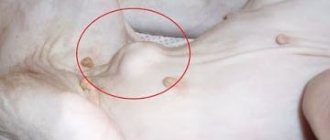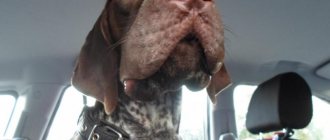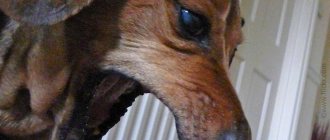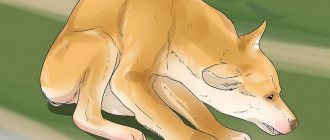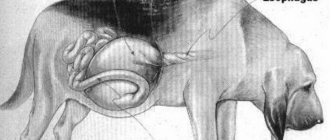When is a lump not a pathology?
Tail injuries are most often suffered by large dogs living in an apartment where there is not enough space for them, and they cannot always wag their tail to their hearts’ content when meeting their owner. In a state of intense joy, the animal often does not control the amplitude of its movements and therefore, hitting its tail against furniture and walls, risks breaking it. This injury is very painful, and it is impossible to miss it. Externally, the tail also changes - it has an unnatural bend. The damage becomes especially noticeable when the dog raises its tail.
After the fracture heals, a bone callus forms in its place, which sometimes turns out to be of considerable size and can be felt like a lump, in most cases painless. It cannot dissolve and remains forever. Education cannot change or degenerate into cancer, as it is natural.
A hard lump on a dog’s tail can also appear if there is a violation in the structure of the vertebrae. In this case, it is present in the dog from birth. If the defect is serious and is detected in the puppy immediately after its appearance, it is worth thinking about tail docking, since such bumps in most cases hurt animals in damp, cold weather, causing more and more discomfort over the years.
How to treat abscesses?
Treatment depends on the location of the abscess and the severity of the infection. Most abscesses are treated on an outpatient basis rather than in a clinic. Therapy involves removing the pus blister either surgically or by draining and irrigating. If a foreign object has caused an abscess, it is extremely important to remove it, otherwise the inflammation will return.
Antibiotic therapy is an integral component of successful treatment of abscesses. The antibiotic is chosen based on the bacteria, and the duration of treatment depends on both the bacteria and the location. It is important to give antibiotics for as long as they are prescribed. It is also important to provide adequate pain relief during abscess treatment. It is important to limit physical activity during the recovery period to allow the tissue to heal unimpeded. If the abscess was surgically removed, then keeping your four-legged friend in silence is mandatory. Anti-inflammatory drugs are prescribed to reduce swelling.
Antifungal medications for dogs are used if the infection contains a large amount of fungus. It is important to finish antibiotics and antifungals as prescribed by your veterinarian to reduce the chance of antibiotic-resistant infections.
The veterinarian should take a swab of the wound and a blood test to determine the type of bacterial infection and determine whether the infection has spread to the bloodstream.
Open wounds in dogs vary depending on three factors: cause, location, and level of contamination. When deciding how to treat open wounds, your veterinarian will consider all three of these factors. There are times when the location of an open wound affects whether it can be sutured or bandaged properly. Bacterial infections are common in open wounds and require thorough cleaning or debridement before suturing or dressing.
Signs of the disease:
- Pain, inflammation, swelling;
- Fever, fever;
- Lethargy, drowsiness, loss of appetite, refusal to eat;
- Frequent licking or biting;
- Hair loss on the tail;
- Bleeding or weeping wounds;
- Unpleasant odor, blackened putrid skin;
- Other specific symptoms appear depending on the location of the infection.
It's all the fault of insects
During the warm season, bumps on dogs’ bodies, including on the tail, appear especially often, since in many animals they are caused by an allergic reaction to substances found in the saliva of blood-sucking insects.
This lump appears unexpectedly and usually has a fairly dense, but not hard, consistency. Its size rarely exceeds a cherry. The formation is pink and less often red. It is not painful, but itchy, which is why the dog can scratch it to a severe wound. If there has been a tick bite (occurs at the base of the tail), then it is important to make sure that there is no suppuration, which requires treatment with antibiotics and ointments that draw out the pus. Itching is relieved with the help of brilliant green, which is applied to the sore spot several times a day. It is impossible to use iodine and preparations based on it, as they will only increase the itching. Education will take place on its own after some time.
Treatment regimen
The treatment regimen for adenoma of the perianal glands is as follows:
- Unneutered male dogs must be neutered. If the tumors are small, they are removed immediately.
- If the tumor is very large, it is removed only 2-4 months after removal of the testes, when it has decreased.
- If the tumor is smaller than 2 cm, it can be removed using cryotherapy.
Adenocarcinoma does not shrink after castration, so treatment for this type of tumor is only surgical. After its removal, the animal is given a course of chemotherapy in order to destroy the remaining cancer cells, as they can metastasize to vital organs.
Bump on a dog's tail photo
Reasons why a dog tucks its tail
For a four-legged friend, the tail, contrary to the erroneous opinion of many owners, is not only an aesthetic decoration and a subject of play for puppies. The organ is necessary for the animal to maintain body balance and helps maintain direction when moving. With its help, the pet makes turns, moves along a complex trajectory, and overcomes obstacles. For hunting and working dog breeds, the tail is important as a kind of rudder when swimming.
An important role is played by the terminal part of the spine in communication with relatives. With the help of one or another position of the tail, an animal can demonstrate its superiority, a leading position, or, conversely, show its submission or fear.
According to veterinary specialists and dog breeders with extensive experience, there are several reasons why a dog’s tail hurts:
- Tail fracture Being an active and mobile creature by nature, a four-legged pet is often susceptible to spinal injuries, including in the area of the caudal vertebrae. Mechanical damage can occur when the tail is pinched by a door or when a vehicle collides.
- Large pets often suffer organ damage in tight spaces, hitting them against walls and furniture. Bruises, dislocations, dislocations and even fractures are common causes of tail disease in dogs.
- Chronic diseases of the spinal column and tendon apparatus. Lumbar spondylosis, arthrosis, and dystrophic processes are often the cause of disruption of the normal mobility of the furry pet’s pride.
The risk group includes hunting breeds of dogs, service dogs, large pets and elderly pets.
We recommend reading about the signs of a dislocated joint in a dog. From the article you will learn about what a dislocation is, the reasons for injuring your pet, whether it can be corrected yourself, and treatment from a veterinarian.
And here is more information about the treatment of a spinal fracture in a dog.
Wen
A soft lump on a dog's tail may indicate a mature wen. It can also occur if an abscess has opened. In both cases, the lump is hard at first. It is not difficult to distinguish a wen from an abscess, since pus flows from the first, and when pressed, a white curdled mass is released from the second, which is easily rubbed between the fingers like butter.
Wen does not pose a danger to the animal and occurs due to improper distribution of fat in the subcutaneous tissue. Such bumps need to be treated only if they are very large and bother the animal. Gradually, the wen matures, and their contents come out after one of the clogged sebaceous glands opens. When the lump goes away, it may either never appear again, or after a while it will pop up again. Ointments that draw out pus are applied to the wen only when it opens. Before that they are useless.
Wen on the tail of dogs, as a rule, do not appear without external influence. They occur most often after an insect bite or blow, when the functioning of the sebaceous glands was disrupted for some time due to swelling.
Cleaning the dog's anal glands
A procedure such as cleaning the dog’s paraanal glands will help avoid the development of inflammation. List of necessary equipment: deep basin, latex or rubber gloves, clean towel, Vaseline.
The pet is placed in a basin, bathtub or shower tray. The assistant firmly fixes the dog by the collar; if necessary, a muzzle is put on the animal.
Using gloved hands, palpate the area around the anus to locate the paraanal glands. After this, the pet's tail is carefully lifted up. Gently squeeze the glands with two fingers, and a beige, sharp-smelling liquid should come out of the sacs.
IMPORTANT! You should not squeeze the glands too hard. If the secretion does not come out, you need to consult a doctor who will carry out cleaning in the clinic or prescribe removal of the sacs.
There is a second way to clean the anal glands. One finger is lubricated with Vaseline, then carefully inserted into the anus. Once the gland is detected, it is squeezed with two fingers, after which the secretion comes out.
Tumors
A lump at the base of a dog's tail can be a benign or malignant tumor. The phenomenon is connected with the fact that in this place there is an accumulation of glands, the tissues of which can suffer from pathological changes. Benign neoplasms do not grow very quickly and are not prone to rupture and suppuration. Cancerous tumors increase in size constantly and rapidly. When the skin tension becomes critical, they open, and the constant release of pus and physiological fluid begins. Bleeding is also possible during periods of tumor disintegration.
The tumors are hard, but if they are malignant, a soft capsule filled with pus or lymph may form around it. Because of this, when palpated, it seems that the dog has a soft tumor with a hard middle. Treatment of neoplasms is only possible through surgery. If they are benign, then after removal the problem can be completely forgotten, and there is no risk of the tumor reappearing. In the case of cancer, even removal does not provide a 100% guarantee of the animal’s recovery - new tumors may appear and the dog may die.
Bumps on the tail of dogs are less common than on other parts of the body, but require no less attention.
Symptoms of benign and malignant tumors
To understand what exactly the detected tumor is and whether it threatens the dog’s life, you need to know the symptoms of benign and malignant tumors.
The safest are benign neoplasms:
- Such tumors are quite soft, elastic or doughy.
- Most often, palpation does not reveal the development of a pain reaction. The only exception may be the same adenoma of the paraanal sinuses, accompanied by their inflammation and suppuration. In these cases there will be pain.
- Benign tumors are not characterized by suppuration or ulceration; they, as a rule, do not bleed.
- The surface is usually covered with wool.
- One of the main symptoms is slow growth.
Malignant tumors are characterized by slightly different signs:
- Extremely fast growth. Often, malignant tumors grow literally “before our eyes,” increasing significantly within a couple of weeks.
- Sores, wounds, cracks and other types of sores can often form on the surface. In many cases, the tumor bleeds.
- Soreness, which is why the animal can constantly scratch or even gnaw the places that bother it. When trying to palpate, the dog reacts inappropriately and may whine or growl.
Papillomas and warts
Lumps like these under a dog’s tail are harmless until they begin to change color and size. They are painless and do not cause itching or discomfort. Such growths usually appear in animals with weak immunity:
- old pets;
- puppies;
- having chronic illnesses;
- individuals who have undergone complex operations, stress.
Warts and papillomas in dogs are caused by papillomavirus, which is transmitted through close contact. The animal’s body does not fight the pathogen, so the dog cannot cope with the problem on its own. The main task is to eliminate tumors in a timely manner and prevent their mass appearance. When the dog sits down, such bumps can become injured and, over time, become malignant. Treatment methods:
- Medication (novocaine injections).
- Surgery followed by drug therapy.
- Freezing with liquid nitrogen (carefully a few drops on the wart).
- Folk (garlic juice, celandine, apple cider vinegar, burning with iodine).
Symptoms of osteosarcoma in dogs
When localized to the extremities, canine osteosarcoma may be asymptomatic for some time or may be accompanied by symptoms of actual or suspected injury, such as lameness, swelling, or tenderness. The main signs of bone tumors in dogs are as follows.
Pain, the main and characteristic symptom of osteosarcomas in dogs, is persistent and progressive. It manifests itself as severe lameness and is poorly controlled by taking non-steroidal anti-inflammatory drugs. This symptom of cancer in dogs is caused by microfractures, spontaneous fractures or periosteal detachment.
A lump or tumor is the second characteristic symptom of bone cancer in dogs. When the soft tissue component of the tumor is pronounced, skin hyperemia and a characteristic dilated venous pattern appear above it.
Restriction of movement in a nearby joint associated with pain, with the subsequent development of so-called pain contracture, is the third hallmark of osteosarcoma in dogs.
If a primary bone tumor is suspected, the animal is subject to a full and comprehensive clinical examination, since any increase in the volume of tissue in a dog (especially a large breed) in the metaphysis is grounds for suspicion of a bone tumor until proven otherwise.
Lipoma will make you wary
A painless formation on or under the tail, regardless of the sex of the animal, may turn out to be a lipoma or, as it is called, a wen. This, at first glance, is a harmless formation that grows extremely slowly and does not make itself felt; it will quickly develop into cancer.
But at the same time, the wen does not cause discomfort; it does not prevent the animal from running, sitting, or meeting its natural needs. In this case, it does not need to be treated. If a lipoma can become a liposarcoma, increase in size and interfere with the normal functioning of the animal, it is removed exclusively through surgery.
Lipoma often manifests itself in the form of a lump or papilloma that appears on the tail. To make a correct diagnosis and prescribe treatment, the doctor must conduct an analysis. He examines the deep groin area and lymphatic system. The doctor takes an x-ray of the abdominal cavity and chest to check for the appearance of secondary growth lesions that appear in any malignant tumors in dogs. If during the research the cause of tumor formation could not be determined, the doctor proceeds with a biochemical analysis.
Benign neoplasms of the perianal (hepatoid) glands can be diagnosed by their types and the results of sampling the pathological formation for research and analysis. It is very difficult to diagnose the histological structural and functional formations of adenoma that develop from glandular cells.
But when making a diagnosis, the doctor takes the growth form as a basis, because the malignant type is distinguished by a tendency towards discreteness and local infiltration. Adenocarcinomas often form secondary foci of tumor development. A doctor will never make a diagnosis based on the appearance of a perianal adenoma; an excisional biopsy must be performed.
Any tumor on the tail should alert the owner and cause a visit to the veterinarian.
Inflammation of the anal glands
Near the animal's anus there are two anal glands, which secrete a specific substance during defecation that helps with bowel movements. The liquid has an unpleasant odor. The older the dog, the greater the risk of inflammation of these glands.
The first signs indicating that the anal glands are full of secretions are fidgeting on the floor and. In this way, the animal tries to cleanse the glands. After some time, swelling appears under the tail.
If you are not very squeamish, try to help your pet yourself. To release secretion from the glands, squeeze the area around the anus with your hands until fluid appears. Or insert one finger into the rectum and use the other to press on the outside, thus pushing out the fluid. The success of the procedure can be judged by the reduction in swelling.
The veterinarian, of course, will carry out these manipulations faster and better. If it is impossible to get rid of the secretion manually, they resort to surgical intervention.
What to do if your dog has a bump
If you notice a lump or skin abnormality, start by:
- examine it and rub it with your fingers to make sure that it is really a lump and not matted fur or burrs;
- if the skin is inflamed, it can be wiped with a disinfectant (antiseptic);
- apply anti-inflammatory and wound healing cream.
Did you know? Rhodesian Ridgeback
-
fearless hunter.
Initially, these dogs were used to hunt lions. Some types of cones can be identified and helped by your pet yourself. Among these: insect bites, cuts, abscesses, hematomas, calluses and other seals.
| Cone type | How to help a dog |
| Ear hematoma | At the clinic, they will install a drainage into the hematoma and explain how to care for it at home. Before going to the doctor, you can apply an ice pack to your ear. Interestingly, in ancient times, starting from Ancient Egypt, hematomas were treated by applying leeches. If a clinic can offer this procedure, leeches are still effective and avoid the bloody mess of a drainage tube. |
| Abscess | If the abscess has opened, you need to rinse the skin with clean water. And then treat with an antiseptic and apply wound-healing ointment. For example, “Ichthyol ointment” or “Levomekol”. The procedure should be repeated 2-3 times a day for a week. But if the abscess is just developing, then you can use drugs that reduce inflammation: Simalgeks at a dosage of 2 mg/kg once a day, Carprofen 4 mg/kg once a day. If the cause of the abscess is a bacterial infection, then antibiotics will be recommended. |
| Insect bites | There is no antidote for bee stings. In most cases, its consequences go away on their own. But to relieve pain and swelling, if you are not allergic, apply an ice pack. "Hydrocortisone" ointment is applied to the bite site after cooling. If there is an allergy, then you need to give your pet an antihistamine: “Diazolin” or “Suprastin” 2 mg/kg. To relieve itching, Apoquel 0.4–0.6 mg/kg. If there is pain, use painkillers “Analgin” or “Spazgan” 1/2 tablet for a small dog or 1 tablet for a large one. |
| Pyoderma | Treated with antibiotics. The most commonly recommended are Amoxicillin, Cephalexin and Clindamycin. In severe cases - Enrofloxacin. The duration of therapy is 8–12 weeks. Topical treatments include sprays and medicated shampoos containing benzoyl peroxide, sulfur with salicylic acid, or chlorhexidine. The skin surface is treated with such preparations once a day for 3–5 weeks. |
| Inflammation of the paraanal glands | To clean the glands at home, you need to purchase petroleum jelly and medical sterile gloves. It is convenient to start treating your pet in the bathroom, since the secretion from the glands has a very unpleasant odor and can get on furniture. You need to insert your gloved index finger into the animal’s anus and feel the sides of the gland. They are shaped like balls. Using light massage movements, “pour out” the contents of these balls. After cleaning, the anal area is washed with detergent. Cleaning at home is not suitable for small dogs. Therefore, the procedure is carried out in a veterinary clinic. If the inflammatory process is not intense, then anti-inflammatory drugs are not prescribed. The pet will cope on its own. If not, then Cephalexin is prescribed for 5–15 days. Suppositories for rectal administration may also be recommended. For severe pain, anesthetics and sedatives are needed. |



